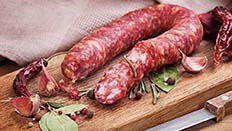Meats and Sausages
Salsiccia di Calabria
Salsiccia di Calabria is a typical Calabrian matured sausage, distinguished by its typical U or chain shape. This shape and the composition of its mixture are the determining factors of the product. The pigs must be raised and slaughtered in the Calabria Region of Italy and the production of the sausage must take place there as well.
| Meats | Metric | US |
|---|---|---|
| Pork shoulder | 500 g | 1.10 lb |
| Pork loin, fat included | 400 g | 0.88 lb |
| Back fat | 100 g | 0.22 |
Ingredients per 1000g (1 kg) of meat
| Salt | 28 g | 5 tsp |
| Cure #2 | 3.0 g | 1/2 tsp |
| Dextrose | 3.0 g | 1/2 tsp |
| Sugar | 2.0 g | 1/3 tsp |
| Pepper | 1.0 g | 1/2 tsp |
| Red pepper | 1.0 g | 1/2 tsp |
| Paprika, sweet | 2.0 g | 1 tsp |
| Fennel seeds, whole | 1.0 g | 1 tsp |
| Red wine | 10 ml | 2 tsp |
| Starter culture, T-SPX | 0.12 g | use scale |
Instructions
- Grind cold pork meat through 10 mm (3/8”) plate.
- Cut cold fat into 6 mm (1/4”) cubes.
- 30 minutes before mixing dissolve starter culture in 1 tablespoon de-chlorinated water.
- Mix ground meat and fat with all ingredients.
- Stuff into large 36-40 mm hog casings. Twist into links 16” (40 cm) long or make traditional horse-shoe shape loops.
- Ferment at 20º C (68º F) for 72 hours, 90 → 85% humidity.
- Dry at 15-12º C (59-54º F), 85 →75% decreasing humidity for 30 days. The sausage is dried until around 30-35% in weight is lost.
- Store sausages at 10-15º C (50-59º F), <75% humidity.
Notes
History
The operators' experience in selecting the cuts of meat used to make the mixture, as well as in adding the fat and the typical Calabrian spices, is of major importance in preparing ‘Salsiccia di Calabria’. The local traditional techniques used in processing these ingredients produce a well-amalgamated mixture which, when packed and matured, determines the product's organoleptic characteristics. The product, the raw material and the name are very closely linked to the social and economic history of the geographical area, which gave rise to typical traditions and customs. Of particular importance is the use of meat from Italian heavy pig breeds, whose feed includes plant products specific to the area. ‘Salsiccia di Calabria’ is therefore closely linked to the geographical area due to the climate of the region, the feed used for rearing the pigs and the human factors at play.
The geographical area of production
The traditional area of production for ‘Salsiccia di Calabria’ is the Calabria Region which lies in the south of Italy and is characterized by a warm-temperate climate with low rainfall concentrated in the winter period. The territory is mainly hilly and mountainous, but, due to its peninsular location, it has over 800 km of coastline on the Tyrrhenian and Ionian Seas. The combination of sea, hills and mountains makes for a specific Mediterranean climate. These favorable conditions are combined with the skills, honed and passed down through time, of the local producers in selecting and processing various cuts of meat for the preparation of the mixture, as well as in creating the traditional chain or horseshoe shape. Moreover, the use of traditional Calabrian sausage-making spices and natural aromas is central to the geographical area. The area in which ‘Salsiccia di Calabria’ is produced and processed is characterized by its typical southern Italian climate with low rainfall, mainly concentrated in the winter period, and its geographical location which is also used for ventilation and temperature variation, thus maintaining optimum conditions within the maturing premises.
Production
The meat used in ‘Salsiccia di Calabria’ must come from pigs reared in the Calabria Region and the average weight of a pig at slaughter must be at least 140 kg. The meat of boars and sows may not be used. The pigs' genetic properties must match those typical of Italian heavy pigs. The pigs diet consists of at least 50 % barley, field beans, corn, acorns or chickpeas. Cassava, potatoes or by-products that could give the meat and fat undesirable flavors and odors may not be used in the feed. In order to ensure that the meat is sufficiently compact for fattening, it is forbidden to feed the animals with swill. Feeding with swill means the use of dairy by-products. For at least the last two months before slaughter, the feed must be high on proteins, of which it must contain not less than 12%. The feed must come from the geographical area of production, according to market availability.
Meat: shoulder (not less than 50%), loin (not more than 15%) and/or leg-ham part (no more than 50%). The percentage of back fat in the mixture should be between 6% and 20% for each kilogram of processed meat. Frozen meat may not be used.
Ingredients: salt, whole or ground black pepper, strong or mild peperone/peperoncito peppers, wine, spices and natural aromas. The following are also allowed: sucrose (common sugar), dextrose, ascorbic acid (E 300), sodium ascorbate (E 301), potassium nitrate (E 252), sodium nitrite (E 250), starter culture.
Processing: the internal temperature of meat and fat to be processes must be between 0 and 3° C (32 – 37° F). The meat is ground, mixed with ingredients and stuffed into natural pork casings and formed into the characteristic traditional U-shape. In commercial production it is permitted to use edible collagen casings to produce straight links between 40 – 80 cm in length. The stuffed sausages are left to mature for at least 30 days.


















